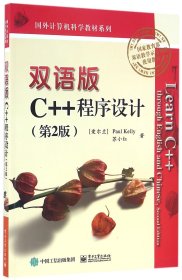很抱歉,该商品可能已下架或被删除
相似商品
-
 双语版C++程序设计(第2版)九品
双语版C++程序设计(第2版)九品¥11.95
-
 双语版C++程序设计(第2版)九品
双语版C++程序设计(第2版)九品¥10.68
-
 [特价]C++程序设计(第2版)八五品
[特价]C++程序设计(第2版)八五品¥4.33
-
 双语版C++程序设计(第2版)八五品
双语版C++程序设计(第2版)八五品¥1.45
-
 C++程序设计(第2版)Paul Kelly(P. 凯利)9787121293580电子工业出版社八五品
C++程序设计(第2版)Paul Kelly(P. 凯利)9787121293580电子工业出版社八五品¥2.62
-
 双语版C++程序设计(第2版)八五品
双语版C++程序设计(第2版)八五品¥5.87
-
 双语版C++程序设计(第2版双语教学示范课程使用教材)/国外计算机科学教材系全新
双语版C++程序设计(第2版双语教学示范课程使用教材)/国外计算机科学教材系全新¥36.70
-
 双语版C++程序设计(第2版) Paul Kelly 电子工业出版社八五品
双语版C++程序设计(第2版) Paul Kelly 电子工业出版社八五品¥3.80
-
 国外计算机科学教材系列:双语版C++程序设计(第2版)全新
国外计算机科学教材系列:双语版C++程序设计(第2版)全新¥27.50
-
 国外计算机科学教材系列:双语版C++程序设计(第2版)全新
国外计算机科学教材系列:双语版C++程序设计(第2版)全新¥22.00
5S 后自动跳转到首页
去首页逛逛
